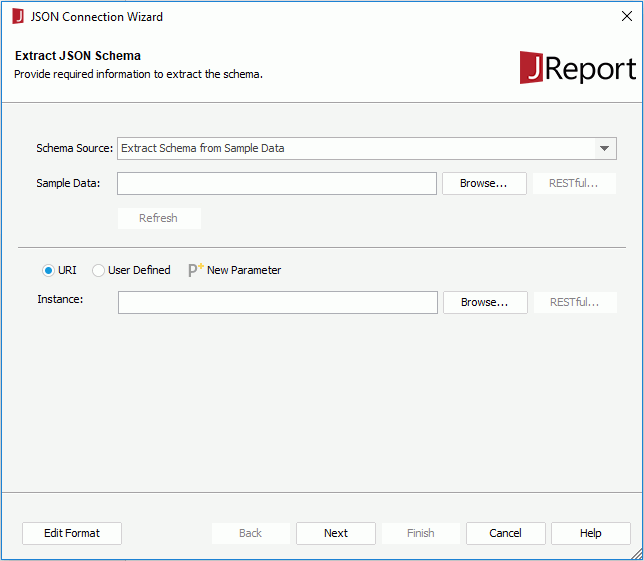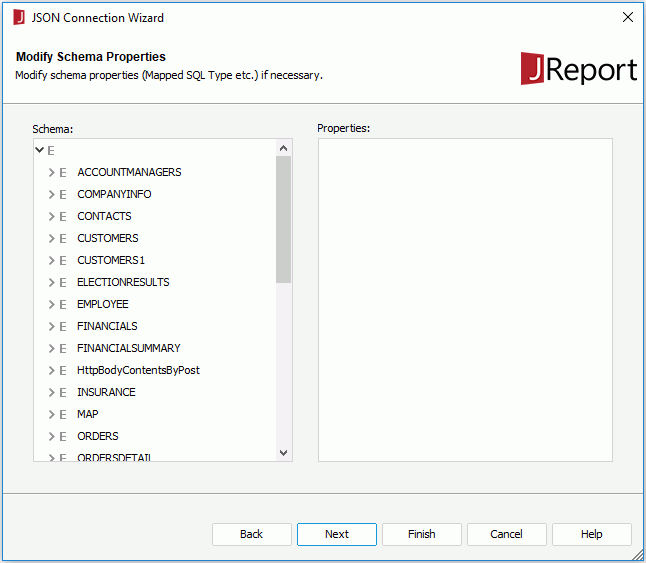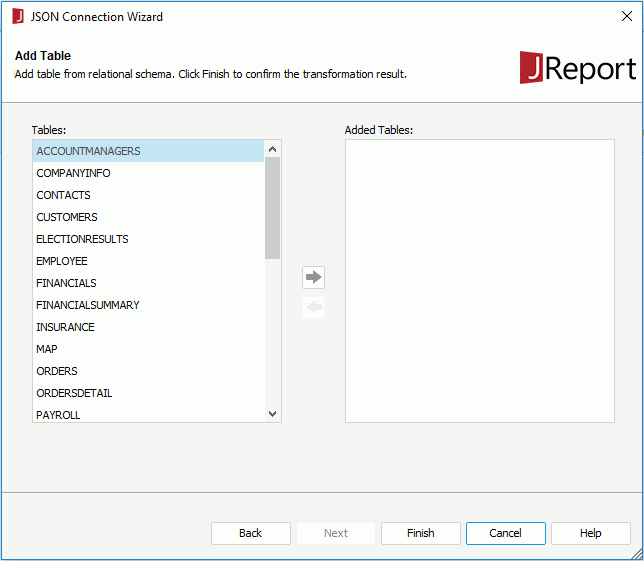 Previous Page Next Page
Previous Page Next Page
This wizard appears when you select JSON and click OK in the New Data Source dialog, or in the Catalog Manager right-click a data source and select New JSON Connection from the shortcut menu or right-click an existing JSON connection and select Edit Connection from the shortcut menu. It helps you to import an XML schema and transform it to a relational schema for future use, and consists of the following screens:
Back
Goes back to the previous screen.
Next
Goes to the next screen.
Finish
Finishes confirming to transform a JSON schema to a relational schema.
Cancel
Does not retain changes and closes this wizard.
Help
Displays the help document about this feature.
Specifies the necessary information to extract JSON schema.

Schema Source
Specifies the source to extract JSON schema: Extract Schema from Sample Data or Extract Schema from Instance Data. Options on the screen differ with the schema source.
Sample Data
Specifies the sample file by clicking the Browse button or inputting the URI string directly in the text box. In the URI string, you can reference parameters and constant level formulas in the current catalog data source and the special field User Name in the format "@fieldname".
http:// or https:// protocol. Clicking it opens the RESTful Data Source Options dialog, in which you can define the RESTful options for the sample data.URI
Specifies to get instance data from URI.
http:// or https:// protocol. Clicking it opens the RESTful Data Source Options dialog, in which you can define the RESTful options for the instance data.User Defined
Specifies to get instance data from user defined interface.
New Parameter
Opens the New Parameter dialog to create a parameter in the current catalog data source. You can then reference the parameter to dynamically specify a JSON instance or user defined interface that matches with the selected JSON schema at runtime.
Instance
Specifies the JSON instance by clicking the Browse button or input the URI string directly in the text box. In the URI string, you can reference parameters and constant level formulas in the current catalog data source and the special field User Name in the format "@fieldname".
http:// or https:// protocol. Clicking it opens the RESTful Data Source Options dialog, in which you can define the RESTful options for the instance data.Refresh
Enabled only when you edit an existing JSON connection. Once you make some change in the wizard and click the Refresh button, the JSON schema information will be reloaded according to what you have changed.
Edit Format
Opens the Edit Format dialog to specify the value formats of the referenced parameters and formulas.
Specifies properties of the JSON schema.

Schema
Lists the corresponding schema structure of the root.  stands for elements,
stands for elements,  stands for the attributes in the XML schema and
stands for the attributes in the XML schema and  stands for the references of elements.
stands for the references of elements.
Properties
Lists all the properties of the selected elements and attributes in the schema.
This screen lists the transformed relational schema structure. It helps you to click Next to confirm the transformation results and go into the Add Table screen.

Adds tables that are transformed from the relational schema to the connection. This screen is not available when you edit an existing JSON connection.

Tables
Lists the tables transformed from the JSON schema.
Added Tables
Lists the tables that you have added from the relational schema.

Adds the selected tables.

Removes the selected tables from the Added Tables box.